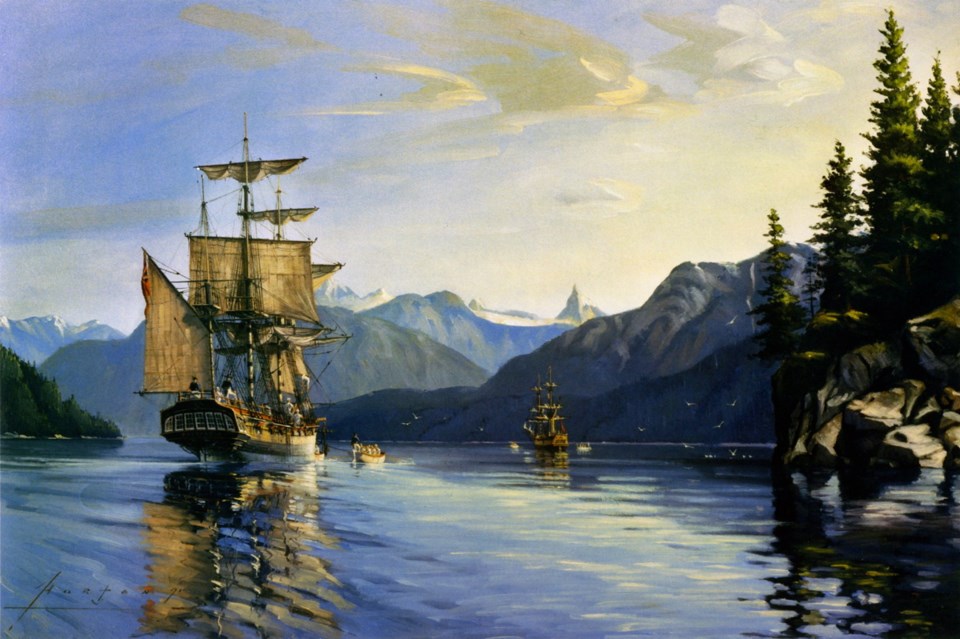 An exhibition of 12 paintings by John Horton drew my attention to the new home of the Maritime Museum of British Columbia, now at 634 Humboldt St. The museum has made repeated and fruitless efforts to secure its dream location, and an eviction notice from its former site in the old courthouse in Bastion Square brought things to a head last year.
An exhibition of 12 paintings by John Horton drew my attention to the new home of the Maritime Museum of British Columbia, now at 634 Humboldt St. The museum has made repeated and fruitless efforts to secure its dream location, and an eviction notice from its former site in the old courthouse in Bastion Square brought things to a head last year.
When I met curator Jillan Valpy at the museum’s new home, she assured me that, even in these much smaller premises, there are positive aspects to the move.
Located just across the street from the Empress Hotel and the Victoria Conference Centre, the museum is already attracting lots of visitors.
“This location is really good for us. It’s manageable,” Valpy told me. After 50 years in the courthouse, a large and ancient building that she described as “dysfunctional,” there were many things out of the museum’s control. Part of moving out was the provision of a new state-of-the-art storage facility for the museum’s vast collection and priceless archive, which was provided off-site by the province.
“A blessing in disguise,” Valpy called it.
Valpy and the other three staff members — not to mention as many as 60 volunteers — have spent the past year making the transition, and now they’re ready to welcome the public. Old friends will see a lot they recognize, including the matchless collection of ship models. Housed in their large, custom-built mahogany cases, these models were created for the shipyard before the Empress and Princess steamships were built. As much as three metres long, each is awesomely detailed.
And a series of smaller displays focus attention on some of the salient chapters of our maritime history. At the moment, a small interactive presentation from Parks sa���ʴ�ý tells the story of the 2014 discovery of the remains of the Erebus, a ship from the 19th-century Franklin expedition in sa���ʴ�ý’s Arctic.
With less display space, outreach will come to play a larger part in the museum’s activities. Its new website will be joined with online catalogues for each exhibit and, after their brief absence, two popular school programs will be back.
The first is about early exploration of this coast by captains James Cook and George Vancouver. The second relates to geography, looking at charting and navigation.
“These days, with computers and GPS, navigation is no longer taught, but what if there is a disaster, and everything goes down?” Valpy asked. “Our message to young people, from Grade 4 to 8, is about knowledge of the sea, the stars, navigation and bearings.”
The museum has scheduled its opening to coincide with this weekend’s Swiftsure activities, which happen on its doorstep — as do the Classic Boat Festival and the Dragon Boat Races.
The museum’s doughty little round-the-world boats, Trekka and Tillikum, have been given display space at the Ogden Point cruise ship terminal, an entrée that might come to have huge significance. To help cruise passengers make the connection, the museum has published a walking-tour map linking Ogden Point and downtown Victoria. They’ve also created a self-guided tour map of historical points in Victoria’s harbour.
Though usually unseen, the largest component of the Maritime Museum is its unparalleled archive, now held in off-site quarters that are spacious, secure and climate-controlled. Valpy expressed obvious delight in leaving silverfish and a century of dust behind at the courthouse. The major part of the museum’s activity these days involves digitizing more of this archive. At the new Humboldt location, there is a small research centre with an extensive collection of photographs of ships and maritime life, and a library of its most-requested books.
Captain Cook is a theme of the display that Valpy was in the midst of installing, and we were watched over by a life-size model of the captain. Provided by Ken Lane, this Cook was formerly in the Royal London Wax Museum on Victoria’s harbour.
A summer-long show of paintings concentrates on artistic reconstructions of the 18th-century voyages of George Vancouver, from the private collection of Vancouver’s John Horton. Horton is the dean of marine artists, and his long career has taken him all over the world, recording activity on the seas for wealthy clients, as well as the Royal Canadian Navy.
Horton has been on the sea all his life, and his passion for accuracy is relentless. Not only are the boats perfectly rendered, but he has sailed to the locations he paints.
A close look at his work reveals an uncanny ability to paint the motion of water in all its moods, and the skies could only have been produced by someone with an experienced “weather eye.” Even the silhouettes of the tiny figures going about their various shipboard activities are drawn with attention to appropriate proportions.
This remarkable skill set results in an irresistible form of storytelling. Horton puts his imagination to work inventing the settings, and choosing telling moments in maritime history. There is nothing stiff in his deployment of oil paint, and he calls on a range of effects, from the loose brushwork of impressionism to a crisp precision fussy enough to satisfy any deckhand. My admiration for Horton’s work was greatly enhanced by reading the book John Horton: Mariner Artist by Peter Vassilopoulos (Heritage House, Surrey, 2007).
Horton is a longtime friend of Victoria’s Maritime Museum, and his willingness to lend these fine paintings — and offer them for sale — is indicative of his support for its new beginnings at 634 Humboldt St. Your support is enlisted for one of Victoria’s cultural gems. Admission is by donation.
The Maritime Museum of British Columbia, 634 Humboldt St., 250-385-4222.



